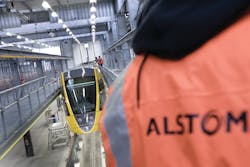When Halsey King first started out in the transit field, maintenance on buses was a lot different than what today’s technicians are doing.
King, who is principal of Halsey King & Associates Inc., said 40 years ago, a bus would come into the shop, technicians would tune it up, then send it back out the door. Then lead was taken out of gasoline dropping the need to clean spark plugs, electronic ignition replaced points and other technology moved in and eliminated the term “tune up” from the technician’s lexicon altogether.
As technology continues to change and different buses are added to transit fleets across the country, maintenance facilities are changing dramatically. And each time they change, King said it always happens the same way.
“I guess I see just about everything start when that new bus shows up in front of your garage,” he said.
Transit agencies are seeing technology evolve in bus and rail fleets, so finding ways to best accommodate maintenance facilities in order to fix these new items can be a challenge. If they challenge isn’t well planned for the new technology designed to enhance the fleet could instead cripple service because technicians are ill equipped.
Back shop support needs upgrades
Gregg Losey, manager of training and manuals for Hyundai Rotem, said back shop support for future train maintenance facilities will require special considerations due to the advent of automatic train control systems, new diagnostic equipment and how malfunctioning units are being replaced.
Manufacturers try to make most equipment “plug and play,” where a faulty item is simply replaced in whole, but Losey, said larger agencies try to fix everything themselves, right down to issues with a PC board.
“This sort of has a trickledown effect because now you’re going to have to upgrade the facilities in the back shops and the electric shops so you can have the proper equipment to work on these types of systems,” Losey said. “The carryover effect is you’re also going to need people capable of doing this work and you’re going to have to rethink your whole training program. There’s still a lot of mechanical work like changing brake pads, replacing panels and seats, but this whole new realm really needs a skilled workforce.”
Losey said the Southeastern Pennsylvania Transportation Authority is one agency trying to fix all equipment, but technology changes in vehicles force changes in maintenance facilities. An example he gave was fixing an HVAC unit on a rail car, which now have temperature control and monitoring systems, so if there’s a hot or cold spot, technology upgrades allow for maintenance workers to adjust the equipment to eliminate the issues and keep a consistent temperature.
By fixing equipment in-house a opposed to sending it back to the vendor allows agencies to overcome issues with vendors going out of business, which Losey said is a real worry.
“They’re worried about the vendor going out of business, so if you don’t have the people trained and you don’t have the back shop in place, you’re going to have to go to another vendor and that’s not very cost effective,” he said.
Eying room for growth
Laurent Fromont, vice president of engineering and platforms for Alstom said two big challenges for maintenance facilities is taking into account environmental health and safety. This includes having the proper testing equipment to keep workers safe along with proper waste disposal.
Challenges come along with trying to plan for fleet upgrades as well, Fromont said, because a rail fleet may expand in size, so agencies need to anticipate for future fleet growth to accommodate growth.
“If you’re going to build a facility to maintain six train cars, we may consider having it built to fix six to eight car frames,” he said. “That way you have the flexibility to deal with this upgrade.”
Wi-Fi connections are becoming essential in maintenance shops, Fromont said, because tablets are being used more and more in diagnostics. If a connection isn’t there, it can stop a technician from being able to service and diagnose a rail car in a quick fashion, which in turn keeps it out of service longer.
King said some agencies will fail to buy enough computer equipment to handle maintenance issues for their fleet and have to send the units out to be diagnosed, which also adds unnecessary costs to the agency.
“There’s no cost savings to buying new buses when you’re not buying the support equipment,” he said.
CNG growth changes bus maintenance
As more agencies continue to look past the traditional diesel powertrain, compressed and liquid natural gas fueled buses are increasingly common options for transit providers to consider.
Sandy Amores, chief of transit maintenance control for Miami-Dade Transit said the agency is meeting with the Federal Transit Administration regularly as leaders there move towards adding CNG buses to its fleet and make the changes to upgrade maintenance facilities in order to work on them in a safe manner.
Amores said the agency will change one of its three maintenance garages in the short term with plans to upgrade all of them to service CNG in the next 10 years. Besides meeting FTA rules, Amores said there are plenty of examples for Miami-Dade to follow in making the changes.
“We know more or less what it takes from our peers running CNG and those who have recently converted to compressed natural gas,” he said. “We’re actually very excited about it.”
The Central Ohio Transit Authority (COTA) in Columbus, Ohio, is in the process of turning its entire bus fleet into CNG powered in the next 12 years, so in anticipation of the move, it spent nearly $33 million during an eight month period renovating and upgrading its McKinley Avenue bus maintenance and storage facility.
COTA Facilities Manager Jon Hancock said in order to accommodate the CNG buses, the HVAC system needed to be upgraded to handle more air, lighting was upgraded, electric conduit needed to be moved along with anything else that could create a spark within 18 inches of the ceiling.
Gas monitoring systems also needed to be installed in the facility along with larger and faster shop doors in order to fit the larger buses and allow errant gas to escape quicker. Monitoring equipment and other equipment need to work together in order to avoid potential gas buildups and the facility had to meet OSHA Class I Division 1 standard with sealed walls to prevent gas leaking into employee gathering areas.
Hancock said he also invited in local fire department officials to inspect the facility and allow them a chance to inspect to so they can determine how to respond if there’s an emergency at the facility.
“While on the east and west coasts this is old news, here in mid-America this is kind of a new technology for everybody,” he said. “While it’s an established technology it’s kind of new where we are.”
While warmer climates can park and work on buses outside of their maintenance facilities, Hancock said COTA made accommodations outside with infrared heaters by fueling areas and the construction of one of the largest CNG refueling areas in the country in order to allow workers to refuel a bus in four to six minutes.
Although the initial capital cost and considerations may seem off putting to some agencies, Hancock said the cheap cost of natural gas makes the return on investment well worth the initial purchase if an agency is able to get the funding.
“This is an opportunity. How many times in public transit have we spent money that really didn’t have a return on investment,” Hancock said. “This one has a significant return on investment with new buses and all this capital equipment and the payoff is in three years.”
An electrifying change
King said bus fleets have an increasing number of alternative fuel options available to them with the advent of CNG, LNG, hybrid and propane powered buses available to agencies, but the advent of electric vehicles is going to change how maintenance is performed dramatically. King joked about how going to electric is tapping into technology more than 100 years old, which is finally being embraced by vehicle builders, but said the change means more agencies will need to think about installing power sources in maintenance facilities to work on the vehicles.
The change also means a lot of regulations will no longer mean many of the federal regulations on safety will apply to shops, diesel and fuel tanks won’t need to be buried in the ground and lots of pollutants will no longer seep into areas surrounding the shop.
“There’s no doubt about it in the larger transit agencies where the general managers get the money, they’re experimenting more and more with electric vehicles, whether it be in series or in parallel or whatever, but that seems to be a growing trend,” he said. “Or course as they do that, the interesting thing about these technologies and if we do go that route, it forces a change on everything and the makeup of the shop. It’s a change that people really don’t appreciate until they look into the rearview mirror and see the benefits down the road.”
About the Author
Joe Petrie
Associate Editor
I came to Mass Transit in 2013 after spending seven years on the daily newsbeat in southeastern Wisconsin.
Based in Milwaukee, I worked as a daily newspaper reporter with the Waukesha Freeman from 2006-2011, where I covered education, county and state government. I went on to cover courts for Patch.com, where I was the main courts reporter in the Metro Milwaukee cluster of websites.
I’ve won multiple awards during the course of my career and have covered some of the biggest political events in the past decade and have appeared on national programs.
Having covered local government and social issues, I discovered the importance of transit and the impact it can have on communities when implemented, supported and funded.

